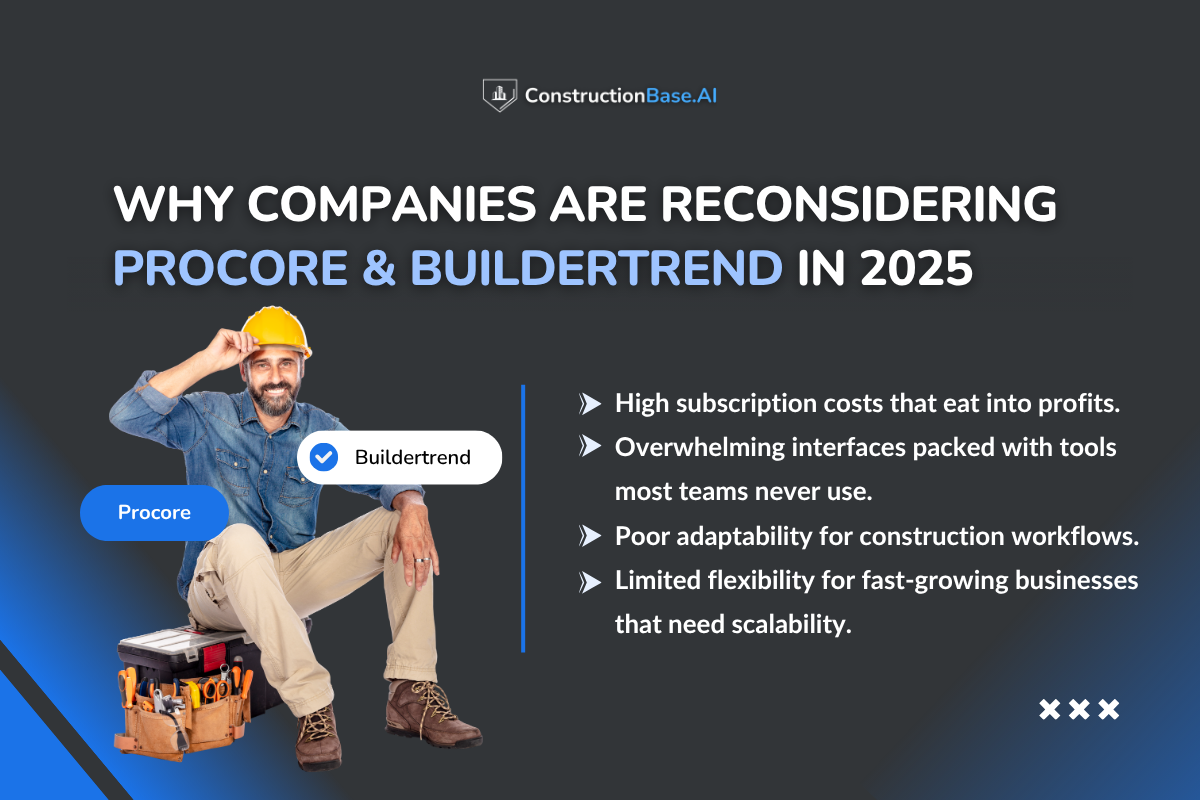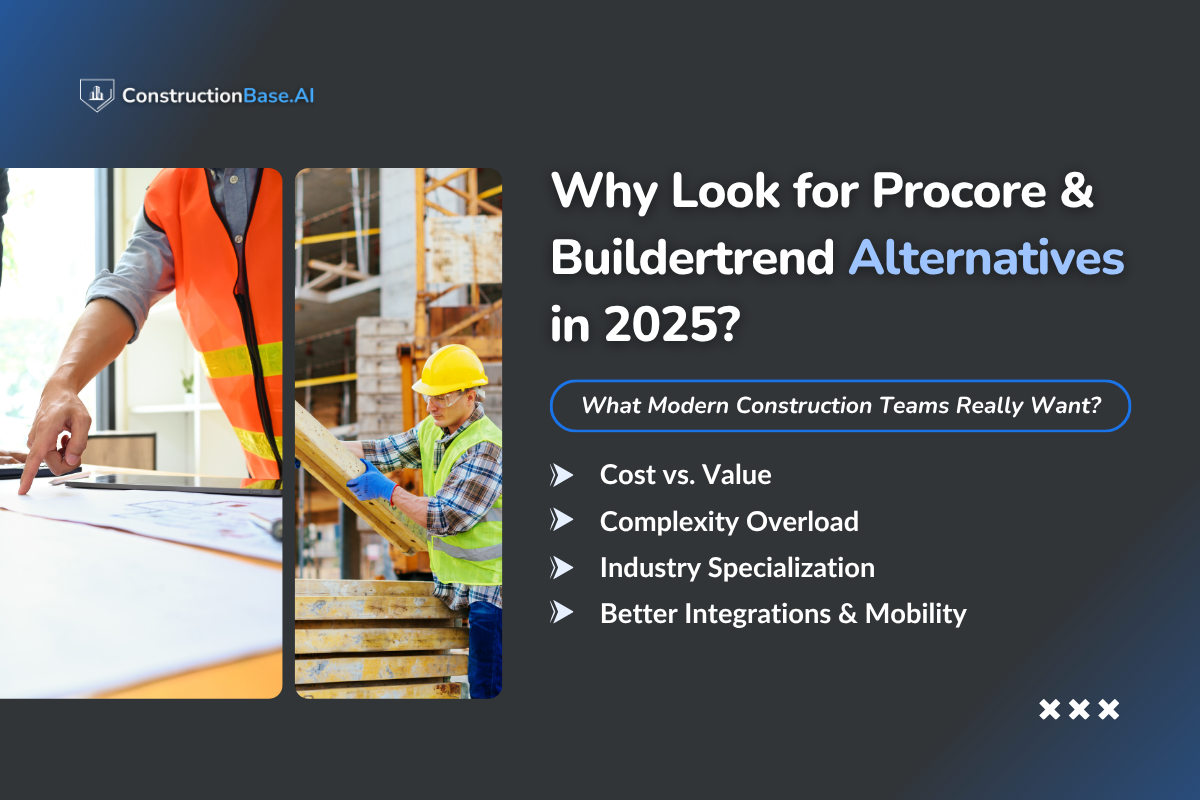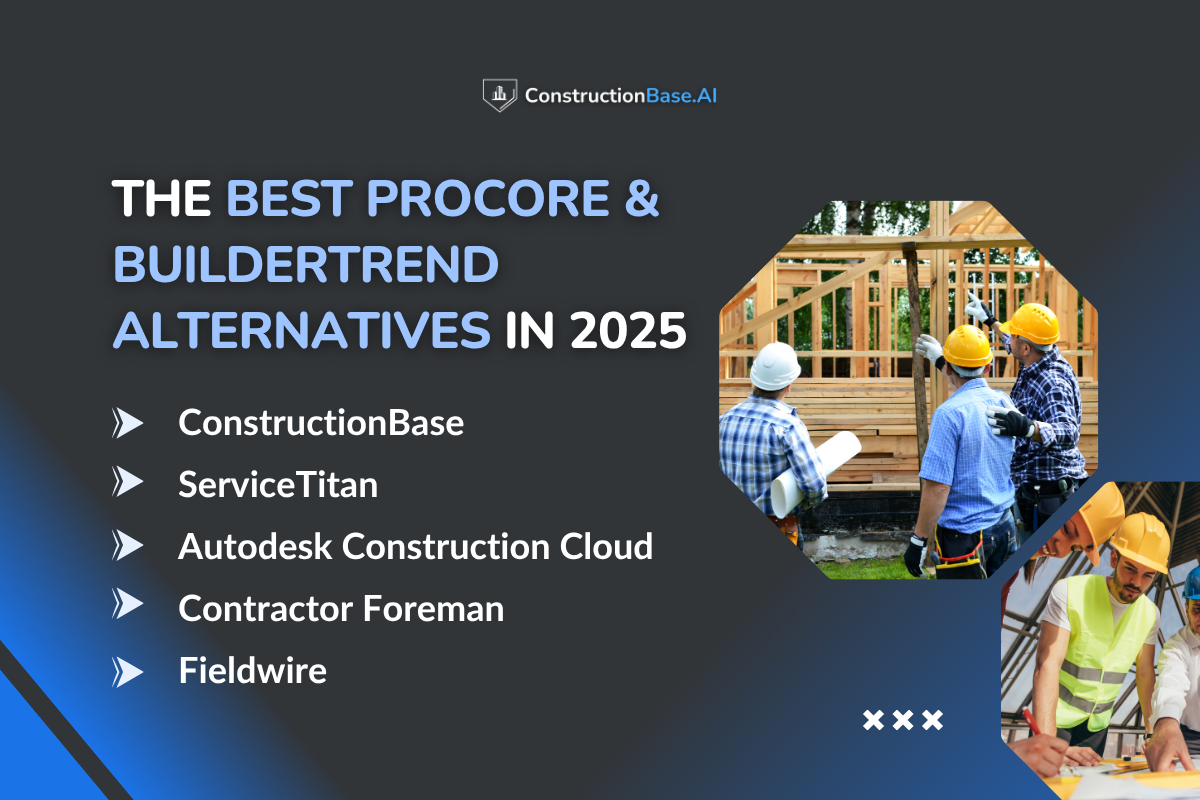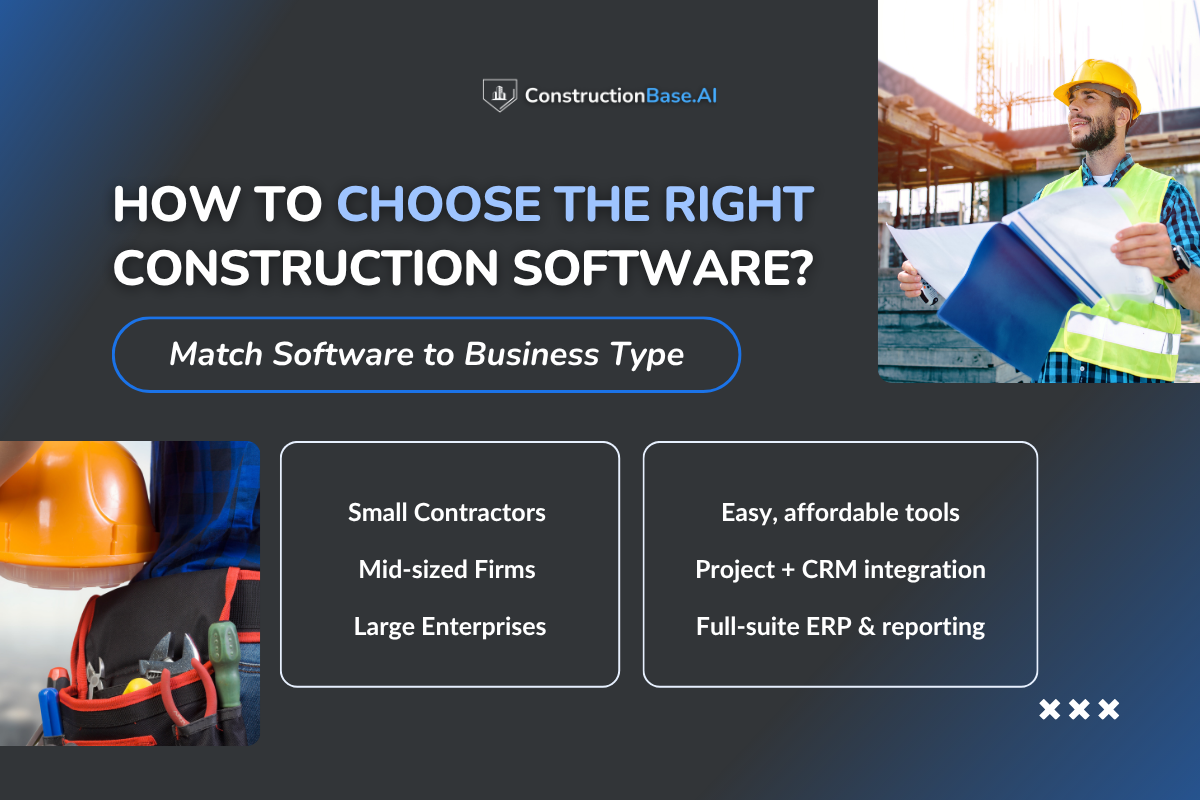When it comes to construction management software, Procore and Buildertrend have long been the big names in the room, powerful, yes, but also complex, pricey, and sometimes… more than what you might actually need.
Now, many growing construction firms, remodelers, and specialty contractors are asking a simple question: Is there a smarter, leaner, more affordable way to manage projects without the extra baggage? And yes, there is!
If you’re scaling your business, managing multiple crews, or just tired of software that feels like a full-time job to learn, you’re about to find tools that truly work for you.
Let's find out the top Procore and Buildertrend alternatives that deliver real value, intuitive design, and flexible pricing, of course, without compromising on the essentials.
Complete Guide to Procore & Buildertrend Alternatives: Smarter Tools for Modern Builders
Today's builders are rethinking their reliance on Procore and Buildertrend, looking instead for tools that offer better value, easier usability, and industry-specific focus.
This guide explores the top Procore & Buildertrend alternatives that combine better project management, financial control, and seamless integration without the complexity or high costs.
Explore modern platforms built for residential contractors, commercial builders, and growing teams that want flexibility, efficiency, and innovation at every project phase.
Key Takeaways
- While Procore and Buildertrend dominate the market, many construction teams find them too complex or costly for their actual needs.
- Modern builders want flexibility, which is why today’s construction companies prefer user-friendly, mobile-first, and AI-powered software that simplifies project management without steep learning curves.
- Industry-focused tools, such as ConstructionBase, Autodesk, Contractor Foreman, and Fieldwire, deliver smarter workflows for residential, commercial, and custom builds.
- Future-ready solutions win: the other alternatives emphasize integration, scalability, and real-time visibility, helping construction firms build a better future.
Understanding The Construction Tech Shift in 2025
Just a few years ago, having software like Procore or Buildertrend was the gold standard.
But today, builders want more speed, automation, mobile-first workflows, and integrations that don’t require a full-time IT department to manage.
The shift isn’t about abandoning the big names; it’s about finding tools that are leaner, faster, and built for how construction actually happens.
> The Numbers Say It All:
U.S. construction professionals waste 35% of their time on inefficient tasks, resulting in an annual cost of $177 billion to the construction industry.
Legacy systems may appear operational, but they often carry hidden costs such as manual workarounds, data errors, and security risks. More often, companies either overpay for features they don't use or switch back to manual methods when the software becomes too complex to use.
If Procore feels heavy and Buildertrend is too limited, ConstructionBase hits the sweet spot. Compare your current process, and let's fix your biggest pain points.
Why Companies Are Reconsidering Procore & Buildertrend in 2025 and Beyond

As projects get more complex and margins tighten, contractors are realizing that “popular” doesn’t always mean “perfect.”
So, as the company expands, builders want:
- Custom-fit workflows for their trade or business size
- Transparent pricing without enterprise-level commitments
- AI-driven automation to cut down on admin work
- Cloud-based mobility for instant updates from the field
Legacy platforms like Procore and Buildertrend were groundbreaking when construction first went digital. However, they are now often seen as too complex, too rigid, and too costly for modern needs.
As 2025 unfolds, many builders are asking a tough question: Are these tools still the best fit for how construction actually runs today? Is there something better?
Before addressing these questions, let’s take a closer look at these two platforms first.
What Makes Procore & Buildertrend Great (and Where They Fall Short)
Both tools are powerhouse platforms that changed how the industry operates.
However, with complexity comes compromise, especially for smaller teams or firms seeking a comprehensive solution that actually gets work done!
| Category | Procore | Buildertrend |
|---|---|---|
| Best For | Large general contractors and enterprise construction firms | Small to mid-sized builders, remodelers, and residential contractors |
| Core Features | Project management, scheduling, task tracking, quality & safety tools Finance tools, budgeting, cost tracking, and billing Document management and centralized storage Collaboration tools for in-app chat, RFI, and submittal management | Project management tools, daily logs, scheduling, and change orders Financial management, bidding, budgeting, and payments Sales tools, leads, and proposal management Communication features and customer portals |
| Mobile App | Enterprise-grade, but it can feel heavy for smaller teams | More intuitive and user-friendly |
| CRM / Client Tools | Limited CRM is better suited for internal coordination | Built-in client portal for a better homeowner experience |
| Learning Curve | Steep often requires training and onboarding | Moderate, easier to get started, but still feature-heavy |
Their Strengths: Integrations, Ecosystem, and Brand Trust
- Procore has built an unmatched ecosystem. With integrations across accounting, design, and field tools, it remains the enterprise favorite.
- Buildertrend shines in customer communication, client portals, change orders, and payment tracking, all in one place.
Both brands are known for their strong trust and reliability. However, this wide range of features can become a burden, as many companies only utilize 20–30% of what they pay for.
Too Many Features vs. Actual Needs
Procore and Buildertrend offer dozens of modules, but many contractors say they spend more time navigating these features than actually using them. The result?
- Longer onboarding times
- Lower team adoption rates
The shift is clear: companies want simpler, modular tools that focus on doing a few things exceptionally well.
Pricing Considerations
Both Procore and Buildertrend have shifted toward tiered, per-user, or per-project pricing, and that’s where frustration sets in.
- Procore’s pricing is often custom-quoted, meaning smaller teams end up paying enterprise-level rates.
- Buildertrend’s plans also offer custom pricing, but scale quickly as you add modules or users.
Many construction firms are realizing that they can achieve the same core functionality at a fraction of the price by using leaner, all-in-one solutions like ConstructionBase, without sacrificing quality or integration.
The future of construction tech isn’t about being the biggest platform in the market; it’s about being the smartest one in your toolkit, and that's where upgrading makes sense.
Why Look for Procore & Buildertrend Alternatives in 2025?

In 2025, many construction businesses, from small contractors to mid-sized firms, are rethinking their tech stacks. The reasons?
1. Cost vs. Value: Paying More Doesn’t Always Mean Getting More
Let’s be honest, Procore and Buildertrend are strong, but their pricing models can make small and mid-sized firms hesitant. Both tools adjust costs based on users, projects, or features, which can quickly become a challenge for budgeting.
Beyond subscription fees, you’ll find hidden costs in the background:
- Extensive training programs (because mastering the software isn’t always intuitive).
- Paid add-ons or integrations with essential tools like accounting software.
- Expensive onboarding support or implementation fees.
For smaller residential builders or specialty contractors, paying enterprise-level prices for project management tools they’ll only partially use doesn’t exactly scream “ROI.”
Modern teams seek construction project management software that provides financial oversight, project tracking, and resource management without requiring a finance degree to afford it.
2. Complexity Overload: Too Many Features, Not Enough Usability
At times, you might feel like your construction management software is doing too much except for what you actually need.
Both offer a comprehensive list of advanced features, including document control, contract management, and quality and safety management; however, this can come at a cost: increased complexity.
If your team requires an entire day to upload a document or track progress, that’s a warning sign. Construction teams want tools that simplify work without daunting them.
3. Industry Specialization: One Size Doesn’t Fit All
Now, here’s the thing: a general contractor doesn’t operate like a subcontractor, and a remodeling firm doesn’t manage work the way a commercial builder does.
Many new software solutions today are designed specifically for niche needs. You’ll find specialized construction management software designed for:
- Home remodelers and residential builders
- infrastructure and commercial projects
Think strong client communication tools, quick project scheduling, task management, and accurate job costing built right in. That kind of specialization isn’t a downgrade; it’s a smart business move.
4. Better Integrations & Mobility: Work Anywhere, Anytime
Today, mobility is everything. Teams want mobile-first, cloud-based construction management software that connects seamlessly with their systems.
Contractors now expect tools that offer real-time project visibility from anywhere, whether it’s field management capabilities, project phases, or schedule management. Flexibility matters!
This results in smoother business operations, enhanced process automation, and improved control over project details and financial data.
So before you invest, check our Construction Software Buyer’s Guide, which breaks down what features truly matter.
Next, let’s see what today’s alternatives are doing better.
The Best Procore & Buildertrend Alternatives in 2025

Here's a list of the top 5 construction management software:
1. ConstructionBase
ConstructionBase is a comprehensive platform that helps you manage all aspects of your project smoothly. It covers accurate takeoffs, estimating, automated scheduling, and effective task management, making every aspect of your construction process hassle-free.
Top Features:
- Automates material takeoffs with instant, accurate calculations to eliminate costly errors and simplify procurement.
- Tracks project progress in real time, helping teams monitor milestones and make quick adjustments to stay on schedule.
- Speeds up bidding and scheduling with automated estimating and dynamic resource allocation tools.
- Enhances collaboration and organization through integrated document management, real-time communication, and powerful reporting features.
Integrations:
- Integrates easily with tools, including HailTrace, accounting, estimating, inventory, and CRM systems, to create a seamless workflow.
Pricing Insight:
- You can request your personalized demo here, as pricing is customized to your needs.
Reviews:
“As a project manager handling multiple commercial and residential builds, I’ve tried plenty of construction project management tools, but ConstructionBase stands out for its balance of simplicity and control." - Brian Hastings, Project Manager
2. ServiceTitan
ServiceTitan is a cloud-based platform that offers a comprehensive suite of tools to manage jobs and business operations, as well as enhance the productivity of field technicians.
Top Features:
- Ensures on-time project delivery with detailed planning, real-time visibility, and seamless coordination between teams.
- Boosts productivity by automating scheduling, time tracking, and reporting for smoother operations.
- Accelerates cash flow through automated billing, progress tracking, and AIA-compliant payment applications.
- Protects project margins with accurate labor forecasting, resource optimization, and real-time financial insights.
Integrations:
- QuickBooks, Ferguson, Winsupply, Johnstone
Pricing Insight:
- You can visit their page to know more about pricing.
Reviews:
"Service Titan has allowed us to consolidate Commercial Service and Construction into a single platform. We now have visibility into progress and performance and can quickly tell which projects are going south. And, with a little deeper dive." - Gary Shurtz, Chief Operating Officer
3. Autodesk Construction Cloud
Autodesk is another robust platform designed for larger construction organizations, incorporating BIM, cost tracking, document control, field tools, and project management features within a single ecosystem.
Top Features:
- It uses AI automation and smart insights to streamline workflows and improve decision-making across teams.
- It centralizes all project documents, from design to operations, for easy access and organization.
- Built-in bid management tools help teams find and choose qualified builders from Autodesk’s extensive construction network.
- Its project management tools reduce rework, catch design issues early, and align office and field teams for smooth execution.
Integrations:
- Power BI, Datagrid, Sage 300, DroneDeploy
Pricing Insight:
- You can visit their page to know more about pricing.
Reviews:
"We can do the entire project in Autodesk Construction Cloud instead of doing BIM coordination in a separate piece of software first." - Jay Mathes, Virtual Construction Civil Lead
4. Contractor Foreman
This is also a cloud-based construction management platform that offers a broad set of features at a relatively low cost, designed with usability in mind for small to mid-sized contractors.
Top Features:
- Contractor Foreman streamlines project management with Gantt scheduling, daily logs, and automated permit and inspection tracking.
- It enhances financial oversight through job costing, detailed dashboards, and advanced permission controls.
- The people management system simplifies workforce coordination with GPS timecards, safety templates, and centralized contact management.
- Finally, robust document control tools, including RFIs, submittals, 100+ reports, and customizable forms, keep every project organized, compliant, and efficient.
Integrations:
- QuickBooks, Google, Outlook Calendar, Zapier, Stripe
Pricing Insight:
- Basic: $49/month,
- Standard: $105/month
- Plus: $166/month
- Pro: $221/month
- Unlimited: $332/month
Reviews:
"Contractor Foreman is more intuitively understandable to me and our type of business. They use the same terminology as we do, and I feel like everyone that I have spoken with are actually contractors and not just a computer programmer selling their product, but understand how we need to solve our problems." - Brian T. (Tower Interiors Group LLC)
5. Fieldwire
This is a mobile-first field management and task coordination tool that enables real-time jobsite tracking, plan viewing, punch-list management, and task assignments, ideal for on-the-go construction teams.
Top Features:
- Streamlines team collaboration by syncing field and office operations, assigning tasks, and accessing real-time drawings from any device.
- Enhances project coordination with task histories, work schedules, and repeatable best practices across multiple projects.
- Enables instant communication through real-time messaging, issue tracking, and interactive markups with notes, photos, and videos.
- Simplifies scheduling and reporting with customizable PDFs, efficient task management, and accurate as-built documentation to minimize risks.
Integrations:
- Dropbox, Egnyte, DocuSign, Google Calendar
Pricing Insight:
- Basic: $0 per user/month,
- Pro: $39 per user/month billed annually
- Business: $64 per user/month billed annually
- Business Plus: $89 per user/month billed annually
Reviews:
"Fieldwire is great because you can capture and control all your data in one spot. I bet you it has probably saved us 2-3 QA/QC people on our project, in all honesty." - Mike Armstrong, Assistant PM
Wondering how some firms grow quickly? Here are some tips on scaling your contracting business.
Which Construction Software Fits You Best?
| Team Type | Recommended Software | Best For |
|---|---|---|
| All-in-One Control Seekers | ConstructionBase | Companies that want a single system for sales, project, and financial control. |
| Small to Mid-sized Teams | Contractor Foreman | Custom home builders and general contractors that manage both commercial and residential projects. |
| Mid to Large Projects | ServiceTitan | Multi-location companies with multiple trades, business units, and a large workforce |
| Large Scale Projects | Autodesk Construction Cloud | Specialty, general contractors, and firms handling enterprise-level projects |
| Field-Only Coordination | Fieldwire | On-site crews, field managers, owners, architects, and designers |
How to Choose the Right Construction Software
> What are the Key Features to Consider
Your job is to find a tool that makes your day-to-day construction workflows simpler while supporting your team across the entire project lifecycle.
- User-friendly interface: First, how intuitive is it for field and office staff?
- Features You’ll Actually Use: Focus on practical tools that improve project planning, communication, and financial tracking, rather than expensive add-ons you’ll never touch.
- Integration & Scalability: Look for ERP integration and compatibility with customer relationship management systems to ensure easy data flow and total project visibility.
- Support & Onboarding: Reliable customer support and quick setup are non-negotiables for keeping your business processes running smoothly without downtime.
Create your checklist. Here are the 10 most important features to consider in construction project management software.
> Pro Tip: Match Software to Business Type

- Small Contractors: Go for affordable tools that simplify scheduling and improve resource optimization.
- Mid-sized Firms: Opt for solutions that seamlessly integrate project management with CRM for enhanced client tracking.
- Large Enterprises: Invest in a comprehensive ERP platform that supports reporting, analytics, and project profitability across multiple departments.
In A Nutshell: Do You Really Need Procore or Buildertrend?
Today, the smarter move isn’t about going big; it’s about going strategic.
That’s why exploring alternatives isn’t a downgrade… It’s a wise choice. Select project management tools that align with your team’s actual workflow, team size, or budget.
Because the goal isn’t just managing projects: It’s managing them smarter. So...
Before You Commit to Big Names, Compare Your Experience
ConstructionBase gives you everything you need, and nothing you don’t. See how your team can run projects, finances, and field operations from one screen.
Book a quick walkthrough and discover why 1000+ contractors use ConstructionBase daily.
FAQ's
1. Is there a better alternative to Procore and Buildertrend?
Yes. Tools like ConstructionBase, Service Titan, Autodesk, Contractor Foreman, and Fieldwire offer similar project management capabilities, without compromising on essential features such as project scheduling, document management, and client communication.
2. Which is the best construction management software for small construction companies?
For small teams or residential builders, ConstructionBase and Contractor Foreman are ideal. They strike a balance between affordability, usability, and scalability, while offering features for project, financial, document, and customer management, as well as mobile access.
3. Can I migrate data from Procore or Buildertrend easily?
Most modern construction management software offers smooth data migration options. You can import key project data, client records, and financial records through CSVs or direct integrations, ensuring business continuity with minimal downtime.
Have questions or need personalized advice?
Talk to an Expert Today and let our construction specialists guide you to success.







